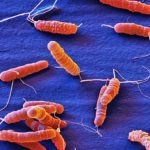Lien vers Pubmed [PMID] – 15228539
Mol. Microbiol. 2004 Jul;53(2):623-38
The virulence of pathogenic bacteria is dependent on their adaptation to and survival in the stressful conditions encountered in their hosts. Helicobacter pylori exclusively colonizes the acid stomach of primates, making it an ideal study model. Little is known about how H. pylori responds to the moderately acidic conditions encountered at its colonization site, the gastric mucus layer. Thus, we compared gene expression profiles of H. pylori 26695 grown at neutral and acidic pH, and validated the data for a selection of genes by real-time polymerase chain reaction, dot-blots or enzymatic assays. During growth in acidic conditions, 56 genes were upregulated and 45 genes downregulated. We found that acidity is a signal modulating the expression of several virulence factors. Regulation of genes related to metal ion homeostasis suggests protective mechanisms involving diminished transport and enhanced storage. Genes encoding subunits of the F0F1 ATPase and of a newly identified Na+/H+ antiporter (NhaC-HP0946) were downregulated, revealing that this bacterium uses original mechanisms to control proton entry. Five of the upregulated genes encoded proteins controlling intracellular ammonia synthesis, including urease, amidase and formamidase, underlining the major role of this buffering compound in the protection against acidity in H. pylori. Regulatory networks and transcriptome analysis as well as enzymatic assays implicated two metal-responsive transcriptional regulators (NikR and Fur) and an essential two-component response regulator (HP0166, OmpR-like) as effectors of the H. pylori acid response. Finally, a nikR-fur mutant is attenuated in the mouse model, emphasizing the link between response to acidity, metal metabolism and virulence in this gastric pathogen.

